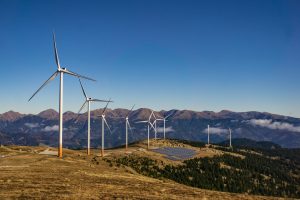Posted on March 8, 2023 by Leslie Carothers
During a pandemic paper purge, I found a corporate newsletter showing me and my boss, George David, then CEO of United Technologies Corporation, at the Earth Technologies Forum admiring a display captioned “Why is UTC a Leader on Climate Change?” Mr. David was among the first business leaders to conclude that action was needed sooner rather than later and that national legislation was warranted. The date of this appearance was October 26,1998! Alas, it took the U.S. Congress 24 more years to pass major legislation to cut greenhouse gas emissions.
In last year’s blog, I touted the climate and energy provisions of President Biden’s proposals for what became the Inflation Reduction Act of 2022. The IRA was approved through the budget reconciliation process, with no Republican support, and signed August 16. The law provides approximately $370 billion in a package of tax credits for zero or low carbon energy production and electric vehicles, including major grants of nearly $150 billion to federal agencies to pass through to state, local, and tribal, and non-profit organizations for many more qualifying climate and energy programs. For details of this massive law, see this helpful summary from Holland & Knight.
The first job for the Biden Administration is to deliver the funding efficiently to energy system developers, state and local government agencies, businesses, and individual purchasers of equipment. Plenty of good lawyers are needed at the Treasury Department and many other federal agencies to develop program guidance to deploy credits and grant funding. Organizations seeking funding to carry out the projects also need counsel. And then there is the big challenge of permitting new clean energy projects. A host of federal, regional, state and local government agencies have significant roles in permitting energy installations as well as expanding transmission lines connecting new energy producers to energy users. Extensive coordination and consultation work is a must to move these projects forward.
Siting and regulating public utility installations of any kind often invite public opposition based on concerns about property values, neighborhood amenities, traffic, noise, water, and other environmental issues. Today’s long overdue focus on avoiding adverse project impacts on disadvantaged communities may make permitting even more complex. For a timely and useful handbook issued by the Electric Power Research Institute on how project sponsors can work effectively on environmental justice issues, see Environmental Justice and Renewable Energy and Storage.
Given all these actors and the prospect of controversy, what can be done to improve decision making for renewable energy projects that not only protects the community’s environment but also rapidly expands clean energy infrastructure necessary to make major reductions in carbon pollution by 2030?
In a new report, the Center on Climate and Energy Solutions offers a strong agenda of recommended administrative policies and legislation to meet the target. Its first recommendation is a call for federal agencies overseeing projects with “clear net climate benefits” to invoke the provision of the U.S. Council on Environmental Quality’s rules that may allow “categorical exclusions” of sites and projects from extensive environmental review if they would significantly reduce carbon pollution with minimal environmental impact. See https://ceq.doe.gov/nepa-practice/categorical-exclusions.html. An example of an activity or action qualifying for a “categorical exclusion” might be an area suitable for solar or wind power development, near where transmission is available or feasible, analogous to “brownfield” sites where habitats are degraded or otherwise not sensitive, and not close to communities of people that could be adversely affected. The Interior Department’s land management office should be able to identify appropriate sites in its vast holdings. The process of defining a new exclusion should begin with consultation with affected States and interested organizations, focusing on siting criteria with reference to examples of potential sites.
The environmental community and its lawyers are expected to be skeptical of excluding projects from the more extensive environmental assessment processes under the National Environmental Policy Act. That law has delivered better decision making by the federal government and greater participation of citizens in the process for over 50 years. But there is wide recognition in the profession that the assessment process has often become too complex and time consuming and that litigation of results delays decisions for years. Such delays can significantly retard progress on climate protection.
Fossil fuel interests may also oppose categorical exclusions for competitive renewable energy infrastructure. Recent news reports are a reminder that some companies in the fossil fuel industry and organizations they support actively oppose expansion of renewable energy. Examples are the Texas Public Policy Foundation’s support of fishers opposed to Vineyard Wind development in New England and the Citizens for Responsible Solar organization that has supported local opposition to solar energy development on agricultural and forested land. Notwithstanding predictable opposition, the Biden Administration should aggressively pursue provision of categorical exclusions for renewable energy projects on federal lands. We don’t have another 24 years to waste.

